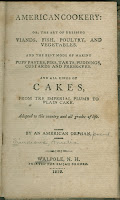 The earliest known recipe combining turkey and cranberries appeared in Amelia Simmons' American Cookery: or, the Art of Dressing Viands, Fish, Poultry, and Vegetables. And the Best Modes of Making Pastes, Puffs, Pies, Tarts, Puddings, Custards, and Preserves, and All Kinds of Cakes, From the Imperial Plum to Plain Cake. Adapted to This Country and All Grades of Life. In this first cookbook written by an American for American consumers, Simmons calls for the use of ingredients specific to North America such as cornmeal from American maize. American Cookery also introduced the use of pearlash, an early non-yeast leavening agent and a precursor to baking powder.
The earliest known recipe combining turkey and cranberries appeared in Amelia Simmons' American Cookery: or, the Art of Dressing Viands, Fish, Poultry, and Vegetables. And the Best Modes of Making Pastes, Puffs, Pies, Tarts, Puddings, Custards, and Preserves, and All Kinds of Cakes, From the Imperial Plum to Plain Cake. Adapted to This Country and All Grades of Life. In this first cookbook written by an American for American consumers, Simmons calls for the use of ingredients specific to North America such as cornmeal from American maize. American Cookery also introduced the use of pearlash, an early non-yeast leavening agent and a precursor to baking powder.This early edition (Walpole, N.H. : Printed for Elijah Brooks, 1812) provides the following recipes for some traditional Thanksgiving dishes.
To Stuff and roast a Turkey or FowlOne pound soft wheat bread, three ounces beef suet, three eggs, a little sweet thyme, marjoram, pepper and salt, and some add a gill of wine; fill the bird therewith and sew up, hang down to a steady solid fire, basting frequently with butter and water, and roast until a steam emits from the breast, put one third of a pound of butter into the gravy, dust flour over the bird and baste with the gravy; serve up with boiled onions and cranberry sauce, mangoes, pickles or celery.
Ask for NH Imprints, Walpole 1812b to see other early American recipes.PumpkinNo. 1. One quart stewed and strained, three pints milk, six beaten eggs, sugar, mace, nutmeg and ginger, laid into paste No. 7, or 3, cross and chequer it, and bake in dishes three quarters of an hour.

